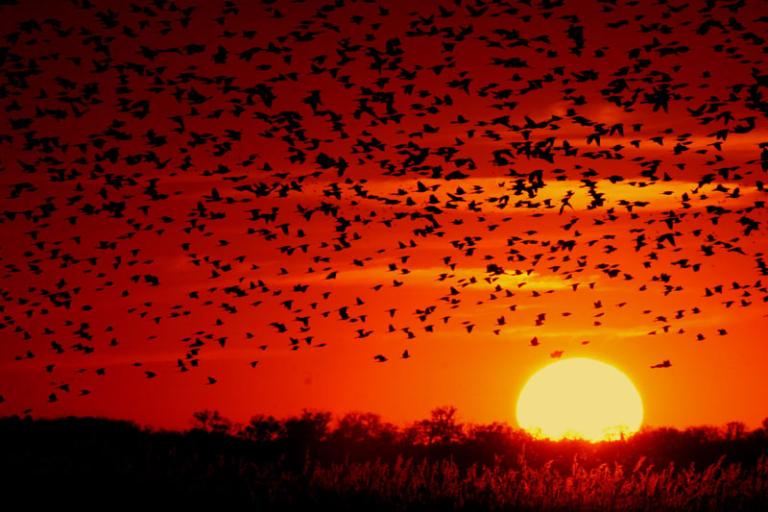I used to be very puzzled when Pagans referred to the solstices as “midsummer” and “midwinter,” since our modern calendar quite clearly labels those days the “first day of summer” and “first day of winter.” “Mid-” and “first” seemed mutually exclusive; how can we be in the middle of something that’s just beginning? It’s one of those slightly bizarre moments when we have to untangle all the overlapping calendars and seasons in which we’re embedded in order to make sense of things: the hottest days of summer and winter are yet to come when we reach their respective solstices, and yet those days are also the midpoints of the sun’s apparent journey across the sky, the time when it seems to rest and stand still for a few days before starting to swing back the other way.
Here on the Gulf Coast, summers are a long and intense affair, with heat in the 90s for months (in fact, as I write this, we’re heading towards a high of 98) and violent thunderstorms that zap the trees and flood the streets almost daily. Even so, it’s taken quite a while for me to begin to really understand the significance that the solstices must have had for my prehistoric European ancestors. I eventually realized that this was because I was thinking of the seasons mostly in terms of weather and temperature—which is how they manifest the most obviously here—rather than in terms of the changes in the amount of available daylight, which are noticeable here but not nearly as dramatic as they are farther north. A Scandinavian student of mine inadvertently drove this point home when I was chatting with her recently about her temporary move from her home country to New Orleans: she surprised me by saying that what seemed the strangest to her here wasn’t so much the heat, but “how dark it is in the summer.” It took me a few seconds to realize what she meant! Thinking about it later, I felt like she had given me some useful insight into why my ancestors in what is now the UK would have felt it so important to mark the solstices with huge stone circles all across their lands.
But the land that is sacred to me has decidedly different joys and challenges from what people in the British Isles faced thousands of years ago; I’m a green-witchy sort of modern Druid living in a sub-tropical climate (and a largely urban one, at that), which is a decidedly different endeavor—not a salmon or a hazelnut in sight! A friend of mine recently said that no one in Louisiana ever says that summer is their favorite time of year, and there’s probably a lot of truth to that. I often feel irrationally irritated this time of year because I can’t really enjoy being outside. While it’s possible to get stuff done outside early in the morning or late in the evening, summer often feels like something to just get through somehow, not a time to celebrate the sun and the longer days. Instead, we spend much of our time hiding from the heat and watching the Gulf for hurricanes.
And yet, we do find ways to deal with the season other than just looking forward to fall. Pagans tend to always be aware of what phase the moon is in, but living someplace where it’s hot from April to October really forces us to adopt the coping mechanism of paying close attention to how the sun moves across the sky as well. To some extent this isn’t any different from anyone else’s concerns—if I park the car here, will it still be in the shade when I get back? Does my child or elderly loved one have enough shade, air-conditioning, sunscreen, or water? Are my pets getting overheated? But if we’re green-Pagan types who have plants that are special or sacred to us, there’s a lot more to keep track of. How many hours of sun will this spot in the yard get? How long will the sun shine through this window? Will the tomatoes survive, or should I pull them up and plant some new ones in a couple of months? Can I even grow all those beloved herbs that are in so many lovely witchy and Druidish books? Chances are, if you live in a climate like this, you can’t, at least not during the time of year when they’re “supposed” to grow. You’re not going to find any nettles or chamomile or dill thriving in July, and trying to make them do so will only end in frustration and heartache. But oh, the lemongrass and Mexican tarragon and Thai basil we can grow! My garden plot, like many around here, is somewhat neglected this time of year; gardening has to enter a holding pattern of its own at midsummer, when spring’s plants are dying back and it’s too early to plant anything for fall. Still, those good tough herbs out there need watering when we go a couple of days without our usual afternoon summer storms, and the weeds will take over very quickly when allowed. Then there are my big plants in pots outside around our apartment, strategically located in morning sun, afternoon sun, full sun, or complete shade depending on how much summer intensity they can stand. I get lots of complements on these, but the truth is, they’re all ones that I’ve discovered through trial and error are reasonably idiot-proof—they can manage pretty well on their own if I just remember to water them and check for spider mites periodically.
So my daily routine from late May to early August—when I have the college-professor’s luxury of setting my own schedule for a while—is full of the mundane tasks of researching/writing, child care, and household chores. But around the edges of these “real” activities are the minutiae of following (and hiding from) the sun each day, all those things involved in paying attention to the season beyond the simple acknowledgment that, well, it’s really hot out. We get direct morning sun in the bedroom windows, which is lovely other times of the year, but right now it gets very hot in there very quickly if we don’t keep the heavy drapes closed all day. My little home office is at the opposite end of the house, and gets bright sun in a side window early in the morning and through the big French doors to the balcony early in the evening. I have plants in both windows, so I have to keep the shade drawn on the side window until mid-morning to keep the heat in there down, then raise it after the sun has moved so the plants can get enough light. Same thing with other plants around the house—keep the direct sun out, then open so they can get bright indirect light, repeating as necessary. I turn up the a/c downstairs a little when we get up, up more when we’re home in the evenings and sitting downstairs, and back down at bedtime; the upstairs a/c, however, has to stay on at a pretty constant rate. During the hottest part of the day, I often escape to my favorite coffee shop to work, where they often have the a/c up too high and I actually have to bring a light sweater. I don’t try to do laundry until at least late afternoon, after the sun is no longer shining directly into our little laundry room attached to the back of the house, and I don’t try to clean the kitchen until evening, when the sun has moved away from its windows.
Finding time and space for spiritual work around all this gets tricky. It’s hard to focus when you’re uncomfortable, of course, so that often means trying to choose between being properly outside or being safely ensconced in what to our modern minds feels like a rational temperature. I generally like to sit out on the balcony late at night for a little quiet time to myself, but this time of year, it’s hot out there even hours after sunset. I then have to decide if acknowledging the season appropriately means that I go out and let myself experience the heat for a while, or just do my spiritual work inside, where the heat will be less of a distraction but I can’t hear any of the tree frogs, katydids, or cicadas doing their thing—just the a/c cycling on and off. It’s a tough call sometimes, but my Grove makes a point of having a sensible indoor rite for Lughnasadh each year! The tradeoff, of course, is that we can be outside for Yule.


















